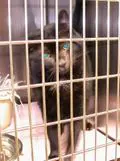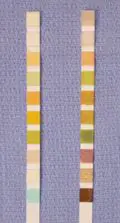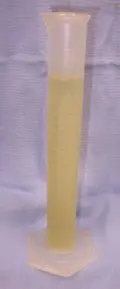 Here's Mimo. He and his house-mate Perry are boarding at the clinic for a few days. "While they're here I want to get their vaccines up to date, and Mimo needs his teeth cleaned. He has really bad breath." The admitting staff asked if he had any other problems. "Well, he vomits a lot, but he seems to feel good. He eats really well." The owner okayed pre-anesthetic blood-work before the dental, signed the release forms, and headed off on vacation.
Here's Mimo. He and his house-mate Perry are boarding at the clinic for a few days. "While they're here I want to get their vaccines up to date, and Mimo needs his teeth cleaned. He has really bad breath." The admitting staff asked if he had any other problems. "Well, he vomits a lot, but he seems to feel good. He eats really well." The owner okayed pre-anesthetic blood-work before the dental, signed the release forms, and headed off on vacation.
When I did Mimo's physical exam, he did look pretty good, except for the periodontal disease. Several teeth have been lost and the gums are really inflamed around those that remain. Here's a funny thing: the last time we saw him (two years ago), he weighed over 15 pounds. Today, 11.9 pounds. That's a 20% weight loss… and he vomits a lot…(but "he feels good"). Maybe we ought to do that lab-work right now.
 I've had a surprise diabetic patient before, and here's another one. His blood glucose was 460mg/dl. It shouldn't be over 150. Let's check a little urine, and it's not only full of sugar, it's full of ketones, as well. That's those two really dark pads at the bottom of the dipstick. They ought to be the same color as the pads on the left, rather than dark brown. Full of ketones is bad.
I've had a surprise diabetic patient before, and here's another one. His blood glucose was 460mg/dl. It shouldn't be over 150. Let's check a little urine, and it's not only full of sugar, it's full of ketones, as well. That's those two really dark pads at the bottom of the dipstick. They ought to be the same color as the pads on the left, rather than dark brown. Full of ketones is bad.
When you can't utilize sugar for energy, you lose it in the urine. You also have to have something else to use for energy. So you break down body fat and use fatty acids for energy. That works, but if you do too much, too fast, the waste products from that process (the ketones)can make you really sick. Fortunately, Mimo still "feels good", still eating well, so we're not in the crisis that we could be in.
We've started Mimo on insulin injections and his prognosis for a normal quality of life is great. I've got to talk to his owner about something, though.
 My notes in the record say that Mimo never goes outside. I've got to wonder about who's changing the litter box. This cat put out four ounces of urine during the night. He has to have been soaking the litter-box. I would think somebody would have been concerned over the fact that the cat is peeing like a race-horse. The owner must have a maid.
My notes in the record say that Mimo never goes outside. I've got to wonder about who's changing the litter box. This cat put out four ounces of urine during the night. He has to have been soaking the litter-box. I would think somebody would have been concerned over the fact that the cat is peeing like a race-horse. The owner must have a maid.
That excessive water-drinking and urination completes the classical picture of the diabetic patient: big appetite, weight loss, excessive water-drinking and urination (usually the first thing you see).
Oddly, in obese cats who develop diabetes, sometimes the first thing we see is vomiting when the ketones go crazy. The cat hasn't lost weight, no change in the water intake/output.
Mimo is a little more on the classic lines. Me, too. I look like Michaelangelo's "David" (only not so muscular and good-looking).


Good post, and good reason for that pre-anesthetic lab work, too. People often question why labs need to be run on a cat that “seems healthy” and your post explains just one of those reasons…
This is not necessarily the case, especially if the owner has multiple cats. But I do hope you did advise the owner to change food too – as an owner of a diabetic cat, OMG food can make ALL the difference. My cat was much worse and food and insulin made all the difference. It’s a lot more expensive, but it’s worth it in the long run. And make sure they don’t try to save money buying the stuff from the natural food store that “looks” as good as say the prescription purina, it makes some cats extremely ill with diarrhea and vomiting.
I thank my vet all the time for the Lantus and Purina DM.
I’m wondering about the reaction of the owner when you tell them the cat is diabetic. Poor thing.
It was something like,
“Whoa! Dude! Glad I had him checked. Thanks.”
I recently came across your blog and have been reading along. I thought I would leave my first comment. I don’t know what to say except that I have enjoyed reading. Nice blog. I will keep visiting this blog very often.
Betty
http://dogfurniture.info
My girlfriend’s diabetic cat MINO was diagnosed back in 2008. After all the information we got at her vets office, it seemed like we’d be giving her Insulin for the rest of her life. Thank god for Insulin. I dont think Mino know how much she means to us.
http://www.entirelypets.com/pzivet40units.html
Thanks for the Info. Your blags are amazing!
I have two cats who were diagnosed with diabetes. They both tested positive for the bacteria which causes cat scratch fever. They were treated with 4 weeks of antibiotics and the diabetes cleared completely. Both have been off insulin completely for over a year. I hear there is a link between this bacteria and gum disease in cats.
Hello, Shawn,
Oddly enough, there are quite a few diabetic cats who are more a case of a kind of “pancreas exhaustion”. They have had excessive insulin demands for a long time and their pancreas can’t keep it up. These cats can recover their ability to produce enough insulin for normal needs, provided you give them replacement insulin in the meantime.
This can happen with other illnesses and biological stresses.
This is yet another reason why it is important to monitor these patients. If they recover their ability to produce insulin, you don’t want to overdose them with the external source.
Congratulations on having cats who made this recovery.
Thanks for reading and writing.